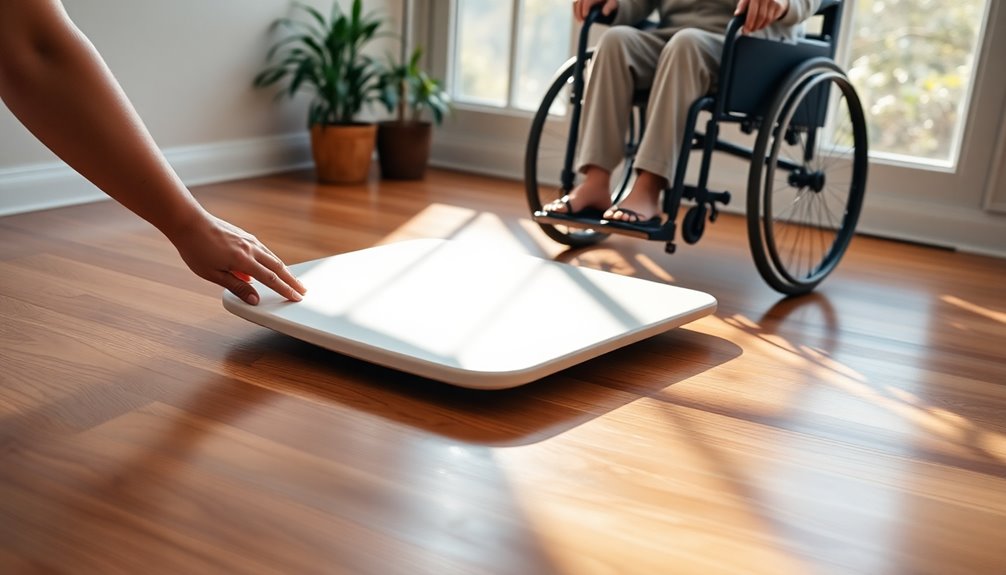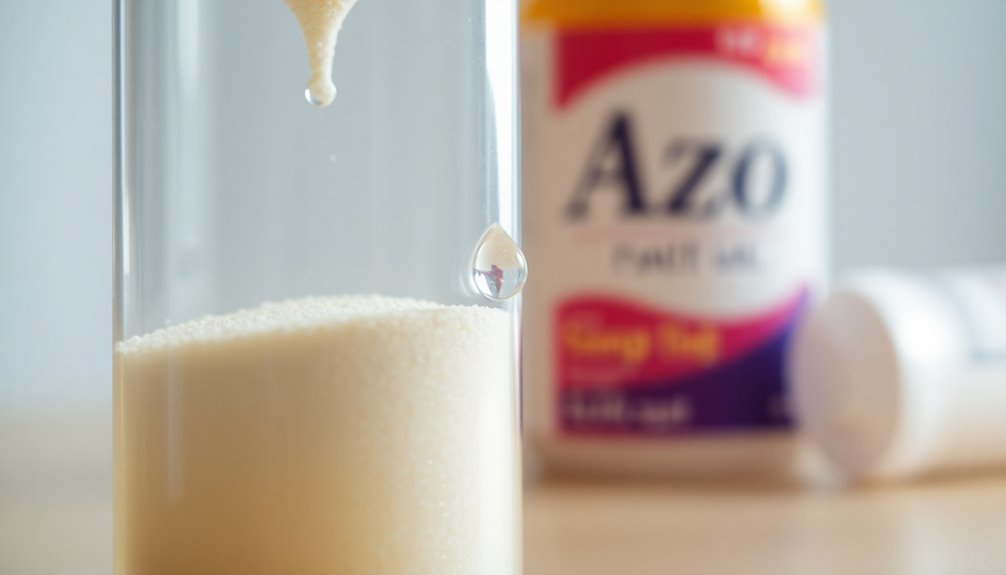Using a transfer board is a game changer for enhancing mobility and independence. Start by positioning the board securely between surfaces, like a bed and wheelchair, making sure they're at similar heights. Always use a gait belt for added security. Sit at the edge of the bed, slide the board under your thigh, and glide onto the wheelchair. Move slowly to avoid injuries, and communicate your steps clearly if someone's assisting you. With practice, you'll build confidence in your transfers. There are even more tips and techniques that can help further improve your experience and safety!
Key Takeaways
- Position the transfer board securely between surfaces at similar heights to facilitate a smooth transfer.
- Use a gait or transfer belt for added security and to reduce the risk of falls.
- Communicate clearly with the person being transferred to ensure comfort and understanding during the process.
- Employ slow, controlled movements to prevent pinching and injuries during the transfer.
- Practice with a caregiver to build confidence and refine your transfer techniques effectively.
Understanding Transfer Boards
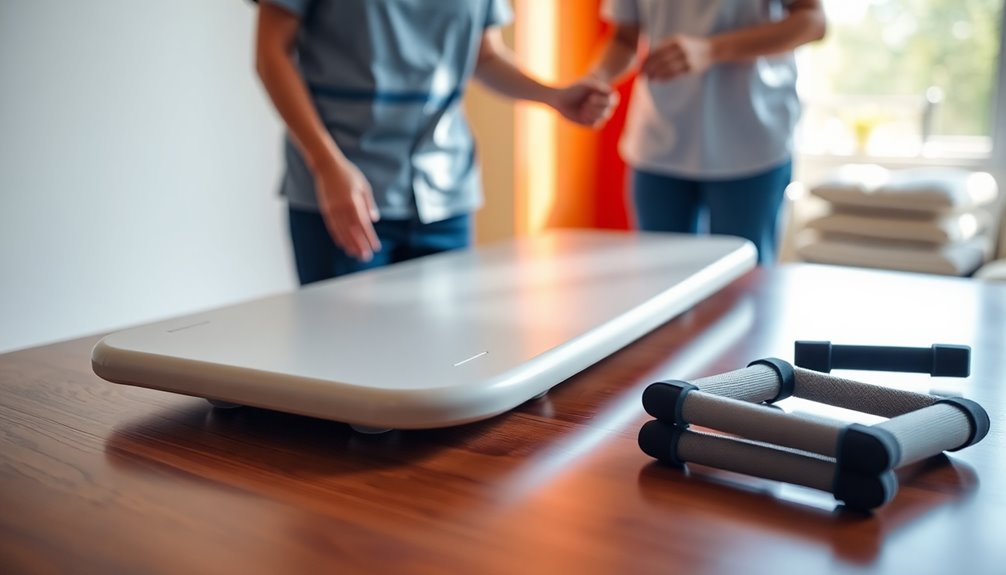
A transfer board's design helps you move smoothly between two surfaces without straining your legs. This flat, rigid device—also known as a sliding board—can be made from wood or plastic, and it's specifically crafted to bridge gaps between surfaces. By using this tool, you can make multiple small movements, which minimizes strain on your body and allows for safer transfers.
One of the key benefits of a transfer board is that it requires less upper body strength compared to other transfer methods. This accessibility makes it a valuable resource for individuals with varying levels of mobility.
To guarantee safety while using the board, it's crucial to have the assistance of caregivers and a gait belt during the transfer process. These precautions help stabilize you and prevent falls.
Additionally, maintaining surfaces of similar height can greatly reduce the effort needed during transfers, enhancing safety and ease.
Understanding how a transfer board works and its advantages can empower you or your caregivers to utilize it effectively, making mobility more manageable and improving your overall quality of life.
Essential Tips for Transfers
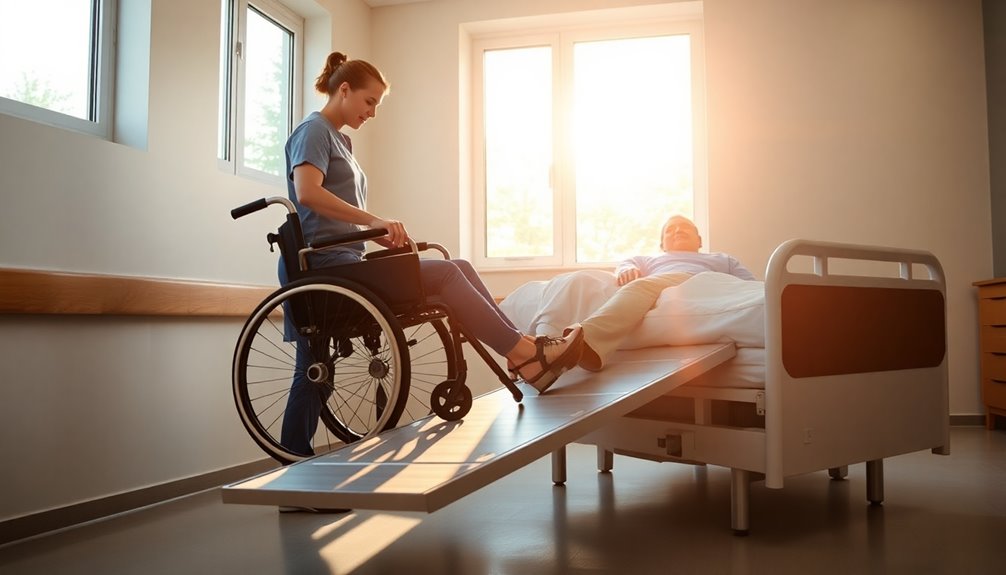
When preparing for a transfer, it's vital to prioritize safety and communication. Always use a gait or transfer belt during transfers to guarantee both you and the patient feel secure.
Position the transfer board within easy reach, and don't substitute it with other objects, as this can lead to complications. Move slowly and carefully, keeping an eye on all body parts to prevent pinching and skin injuries.
Before initiating the transfer, mentally organize the steps you'll take. This preparation helps everything go smoothly. Make sure to communicate clearly with the patient; confirm they're ready before you start.
Aiming to transfer between surfaces of similar height is significant. This approach minimizes effort and reduces the risk of strain on your body and the patient's.
Remember, every transfer is unique, and adapting to each situation is key. Take your time, and don't rush the process. Safety and comfort should always come first.
Transferring From Bed to Wheelchair
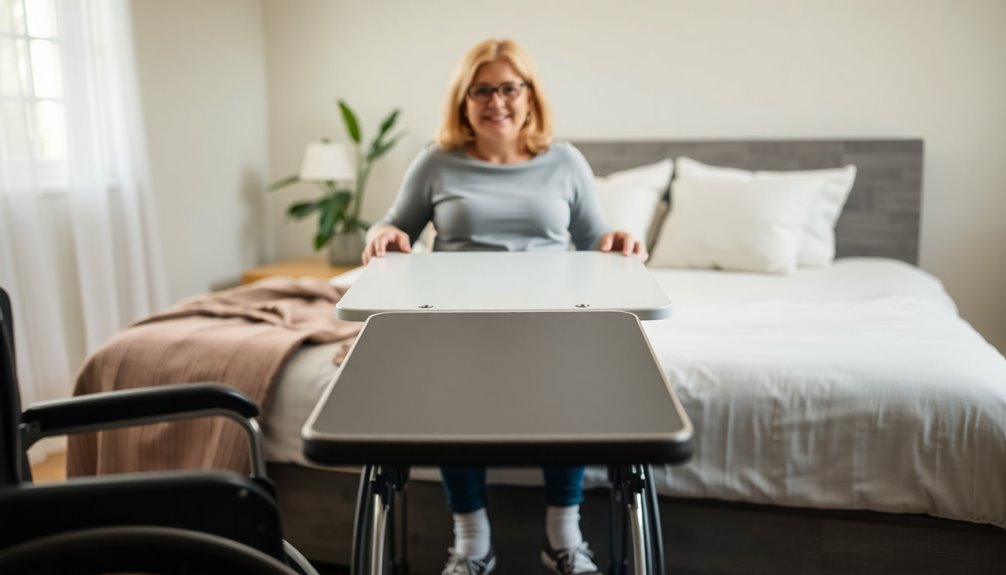
When transferring from the bed to your wheelchair, preparation is key.
Start by positioning the wheelchair at an angle close to the bed and ensuring you have a stable base to work from.
With everything set, you can move on to the steps for a safe and smooth transfer.
Preparation and Positioning
Transferring from bed to wheelchair requires careful preparation and positioning to guarantee safety and comfort.
Begin by sitting on the edge of the bed with your feet flat on the floor. This stable starting position is essential for a smooth transfer.
Next, position the wheelchair close to the bed, angled as recommended by therapists, to facilitate an easier shift.
Before you move, lock the wheelchair wheels to prevent any unwanted rolling. Remove the nearest armrest and move the footrests aside to create a clear path for your transfer.
Once everything's set, slide one end of the transfer board under your thigh, making sure the other end rests securely on the wheelchair seat.
Now, you're ready to transfer. Use your arms to push up, unweighting your body, and make small, controlled movements to glide onto the wheelchair.
Remember, maintaining a steady and balanced posture during this process is key to avoiding any accidents.
Steps for Safe Transfer
To guarantee a safe transfer from the bed to the wheelchair, start by sitting at the edge of the bed with your feet flat on the floor. This guarantees you're stable before moving.
Next, position the wheelchair close to the bed at an angle, lock the wheels, and adjust the footrests and armrests for easy access.
Follow these steps for a smooth transfer:
- Slide one end of the transfer board securely under your thigh, making certain it points down towards the wheelchair. This creates a smooth bridge for your transfer.
- Use a gait belt for safety, gripping it firmly to maintain stability.
- With your arms, push up to unweight your body. Keep your back straight and knees bent to prevent injury.
- Gradually shift your weight in short movements across the transfer board into the wheelchair.
Additionally, maintaining proper body mechanics during transfers can significantly reduce the risk of injury.
Transferring Between Other Surfaces

When transferring between surfaces like a wheelchair and a toilet or couch, there are a few common scenarios to take into account.
It's vital to follow safety precautions and keep a few tips in mind to guarantee smooth transfers.
Let's explore how to make these changes easier and safer for everyone involved.
Common Transfer Scenarios
Several common shift scenarios require careful planning and technique to guarantee safety and ease. Understanding these scenarios can make a significant difference in your daily routine. Here are some key situations to contemplate:
- Wheelchair to Toilet: Position your wheelchair at an angle close to the toilet, moving the footrests aside for a clear path.
- Couch Transfers: Use the same method as bed transfers by positioning your wheelchair close to the couch. The transfer board provides stability and ease during the move.
- Car Transfers: Roll down the window for grip support. Slide the transfer board under your thigh and recline the seat slightly if you need more headroom.
- Lock and Remove: Always lock your wheelchair wheels and take off the nearest armrest before you start. This helps prevent any accidental movement during the transfer.
Practicing these transfers with a caregiver can increase your confidence and refine your techniques, ensuring smoother shifts.
With a little preparation and practice, you'll find these transfers become easier and more manageable in your daily life.
Safety Precautions to Consider
Transferring between surfaces like a wheelchair and a toilet or couch requires careful attention to safety precautions.
First, make certain the surfaces are at a similar height. This minimizes effort during the transfer and reduces the risk of accidents. If you're transferring into a car, adjust the seat to its furthest back position and slightly recline the backrest. This extra space can make the process more comfortable and safe.
Always use a transfer board specifically designed for this purpose. Substituting it with other objects can lead to instability, increasing the risk of injury. Secure the transfer board firmly in place before you start the transfer.
A gait belt can also provide a secure grip, enhancing safety throughout the process.
Communication is key. Always discuss the steps involved with the person you're transferring and confirm they're ready before you begin. This not only guarantees a smoother operation but also reassures them, making the entire experience less stressful.
Tips for Smooth Transfers
To guarantee smooth shifts between various surfaces, like a bed and a wheelchair, it's crucial to plan your approach. Here are some tips to help you execute transfers safely and efficiently:
- Verify Height Similarity: Before starting, check that both surfaces are at similar heights. This reduces strain and makes the shift easier.
- Position the Transfer Board: Always place the transfer board securely and within reach before you begin. A stable board is key to a smooth transfer.
- Adjust for Car Transfers: When getting into a vehicle, adjust the car seat back for comfort and roll down the window. This provides extra support and ease of movement into the car.
- Move Slowly and Monitor: While transferring, use slow and controlled movements. Keep an eye on your limbs to avoid pinching or injury.
Finally, once you're settled in the car, don't forget to fasten your seat belt immediately. This adds stability and guarantees your safety during travel, allowing you to focus on your journey ahead.
Best Practices for Back Safety

Back safety is vital when using a transfer board, and following best practices can greatly reduce the risk of injury. Here are some key strategies to keep in mind:
| Best Practice | Description | Benefits |
|---|---|---|
| Maintain Bent Knees | Keeping your knees bent while transferring helps protect your spine. | Reduces strain on your back. |
| Use a Gait or Transfer Belt | This provides a secure hold during transfers. | Minimizes strain on the caregiver's back. |
| Organize Steps Mentally | Planning your transfer steps enhances efficiency. | Reduces the likelihood of accidents. |
| Seek Help When Needed | Don't hesitate to ask for assistance. | Guarantees proper technique and safety. |
Additionally, regularly engaging in back-strengthening exercises can improve your overall stability. By incorporating these practices into your routine, you'll enhance your safety and effectiveness during transfers. Remember, proper technique is vital, so consider practicing under the guidance of a healthcare provider. Prioritizing these strategies will not only protect your back but also make the transfer process smoother and more comfortable for everyone involved.
Enhancing Mobility With Transfer Boards

Using a transfer board can greatly enhance mobility for individuals with limited leg use. This simple tool allows for safe and efficient transfers between surfaces, reducing the risk of falls and injuries.
With proper technique, you can enjoy smoother shifts, especially between surfaces of similar height, minimizing strain on both you and your caregiver.
Here are four key benefits of using a transfer board:
- Accessibility: Transfer boards require less upper body strength than other methods, making them suitable for a wider range of users.
- Safety: Incorporating a gait belt during transfers offers added support and safety, allowing caregivers to assist more effectively without straining their backs.
- Confidence: Regular practice with a transfer board boosts your confidence and independence in mobility, enhancing your overall quality of life.
- Efficiency: Using a transfer board can streamline the transfer process, saving time for both you and your caregiver.
Resources for Further Assistance
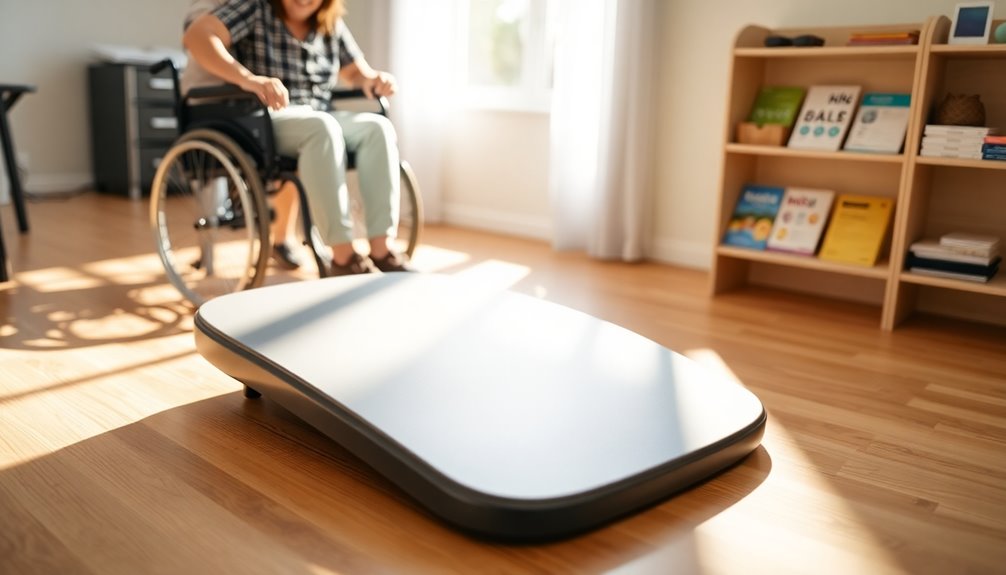
Accessing the right resources can greatly improve your experience with transfer boards, ensuring safe and effective use. Local hospitals and rehabilitation centers often offer training sessions that enhance your skills and confidence. You might also explore online resources like the National Institute on Disability, Independent Living, and Rehabilitation Research (NIDILRR), which provides helpful instructional videos and guides.
Community organizations and support groups for individuals with mobility challenges frequently host workshops and hands-on training. Consulting with a physical therapist can give you personalized guidance tailored to your specific needs and abilities. Don't forget that many manufacturers of transfer boards offer customer support and educational materials to help you understand how to use the device safely.
Here's a quick reference table to help you find resources:
| Resource Type | Examples | Benefits |
|---|---|---|
| Training Sessions | Local hospitals, rehabilitation centers | Enhanced safety and efficiency |
| Online Resources | NIDILRR, instructional videos | Accessible guidance anytime |
| Community Support | Local workshops, support groups | Hands-on practice and support |
| Professional Guidance | Physical therapists | Tailored techniques for individuals |
Frequently Asked Questions
How Do You Use a Transfer Board?
To use a transfer board, start by positioning it securely between the surfaces you're transferring between.
Sit on the edge of the bed with your feet flat, ensuring the wheelchair is locked and angled close.
Slide one end of the board under your thigh, then use your arms to lift and shift your body.
Make small, controlled movements to glide across the board, keeping your body parts clear and using a gait belt for safety.
Can You Use a Transfer Board by Yourself?
You can use a transfer board by yourself, but it's no walk in the park!
Imagine this: you're balancing on a tightrope, every move matters. While it's possible, you'll want to practice first.
Make certain the surfaces are even, and don't forget that gait belt for extra security.
Think through each step carefully, and take it slow. Rushing can lead to slips or scrapes, and we definitely don't want that!
Stay safe!
What Do Transfer Boards Help With?
Transfer boards help you shift safely between surfaces, like from your bed to a wheelchair.
They reduce the strain on both you and your caregiver, enabling smoother transfers with minimal effort. By using a transfer board, you can enhance your independence, allowing you to perform transfers with less assistance over time.
Plus, they lower the risk of falls and injuries, providing a stable and secure way to move when you have limited mobility.
Where Should the Caregiver Be Positioned During a Transfer Board Transfer?
During a transfer board transfer, you should position yourself close to the patient, ideally on the side where the board is placed.
Stand with your feet shoulder-width apart for stability and balance. It's essential to hold the gait belt securely to prevent slips or falls.
Positioning yourself at the patient's head or shoulder level enhances communication and reassurance, making the transfer smoother and safer for both you and the patient.
Conclusion
Using a transfer board can make your life smoother, like gliding on ice. With the right techniques and safety practices, you can enhance your mobility and independence. Remember, it's not just about the transfer; it's about regaining control over your daily routine. Don't hesitate to reach out for assistance if you need it, and keep practicing until you feel confident. Embrace the freedom that comes with mastering this simple yet powerful tool!
